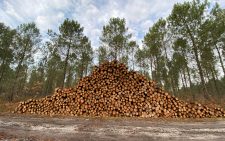Forest degradation costs Kenya Sh534 billion annually

More than 20 per cent of Kenya’s landmass is degraded, a report has revealed, amid fears the country could be losing more forest land to other uses.
The latest forest status report has shown that about 12,000 hectares of forest land are converted to other uses every year, while natural causes have also contributed to the degradation.
Unfortunately, this is in the backdrop of shortfalls in the national target to restore 5.1 million hectares of degraded forests by 2030 under the implementation of African Landscape Restoration Initiative (AFR100).
The government also has a national commitment to restore 10.6 million hectares of degraded forests by 2032 through the 15 billion Tree Growing National Landscape and Ecosystem Restoration Strategy.
“In recent years, the country has experienced increased degradation in existing forests and other landscapes,” shows the Forest Status Report 2024- Kenya, showing a grim picture of how much degradation costs the country’s economy.
The assessment by the Kenya Forest Service (KFS) shows that degradation is estimated to cost the economy at least three per cent of the country’s GDP annually (about Sh534 billion).
In Kenya, the average annual forest degradation rate is estimated at 14,934 hectares with the deforestation rate at an annual average of 84,716 hectares.
Forests are fragmented across the country. Combined, forests cover over 37 million hectares, out of which 2.1 million hectares are woodlands, 24.8 million hectares are bush lands and 10.7 million hectares are wooded grasslands.
According to recent reports, the land area under forest in Kenya is approximately 8.83 per cent of the country’s total land area under forest cover.
This information is based on the National Forest Resources Assessment (NFRA) Report 2024.
“Through the support of the World Resources Institute, entire Kenya was mapped and an area of 38.8 million hectares was found to be degraded,” the report presented by Alex Lemarkoko, the national Chief Conservator of Forests.
Climate change
The report highlights the extent and distribution of forest cover, trends in deforestation and degradation, drivers of forest change, effectiveness of conservation programs and the challenges and opportunities facing the country’s forests.
According to Lemarkoko, as one of recommendations, the report is advocating for an urgent need for concerted action to address deforestation, illegal logging, land degradation and climate change.
“As the custodians of these precious ecosystems, it is imperative that we assess the status of our forests so as to identify emerging threats, and take decisive actions to ensure their sustainable stewardship for future generations,” he said.
The report identified agricultural expansion, unsustainable logging, livestock grazing in forests, rapid population growth and inadequate forest governance as the key drivers of forest degradation in Kenya.
“Cumulative results of the drivers have led to destructive events that include; forest fires, poaching of forest land, farming, livestock grazing in the forest and introduction of invasive species,” says the report.
In view of this,the report shows that a total of 356 species , sub-soeciea and varieties in Kenya have so far been classified as threatened or near threatened. Of these, 24 taxa or 21 species are critically endangered, 111 are endangered about 83 species, 167 are vulnerable (128 species), and 67 are near threatened (56 species).
Threatened species
“Threatened species are particularly common in the Fabaceae, Euphorbiaceae and Rubiaceae families. The highest number of threatened species, 95 in all, is found in the Coastal forest hotspot, mainly because of habitat fragmentation and the extensive loss if the highly-diverse coastal forest ecosystems such as Arabuko Sokoke forest and the Kaya forests,” the report highlights.
Speaking during the launch of the report yesterday, Environment, Forestry and Climate Change Cabinet Secretary Aden Duale warned cartels canvassing to buy forest products, especially timber, to sell to saw millers.
The CS said that by addressing the wood deficit and promoting reforestation and strengthening the country’s commercial forest sector, this can be enhanced significantly.
He noted that Kenya’s forest sector has the potential to sustainably supply 31.4 million cubic metres of wood annually, reducing reliance on imports and boosting our economic growth.
“I therefore want to make it very clear this morning, because there are people who go to the chief forest conservator, who go to the other team at the Kenya Forest Service. However, since forests are public assets, I must warn that they are not individual assets,” he said.
Duale directed the Chief Conservator that anybody who takes a shortcut, be referred to his office.
And he said that since forests are public assets, they should be sold in accordance with the law.
“The 150,000 hectares of our commercial forest can only be sold and it’s an asset available to Kenyan businesses in the timber industry,” he said.
However, he said it can never be sold outside the law, but through the Public Procurement and Asset Disposal Act.










